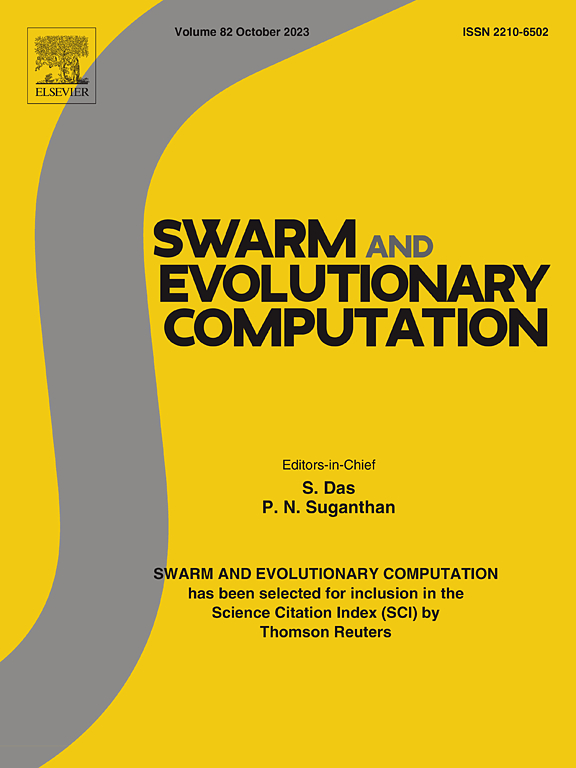A temporal-segmentation-and-fusion-based large-scale constrained multi-objective evolutionary algorithm for coal mine integrated energy systems dispatch
IF 8.2
1区 计算机科学
Q1 COMPUTER SCIENCE, ARTIFICIAL INTELLIGENCE
引用次数: 0
Abstract
Under the dual-carbon policy, the optimization of coal mine integrated energy systems (CMIESs) has garnered increasing attention from researchers. However, the characteristics of multiple optimization objectives, strong coupling constraints, and high-dimensional decision variables pose significant challenges for optimization methods. Existing constrained multi-objective optimization algorithms struggle to effectively solve such problems with multiple complex characteristics, and they are prone to getting stuck in local optima. To address this issue, this paper proposes a temporal-segmentation-and-fusion-based large-scale constrained multi-objective evolutionary algorithm, which divides the evolutionary process into two stages. In the subspace optimization stage, the large-scale space is divided into multiple smaller subspaces according to the problem’s temporal divisibility characteristics, then these subspaces are progressively integrated and optimized by using a portion of the computational resources. Once all subspaces are integrated, the original space optimization stage is activated, then the remaining computational resources are employed to search the original large-scale space. In addition, a differential evolution mutation strategy based on dynamic neighborhoods is studied, which effectively balances global exploration and local exploitation, guiding the population toward promising regions in the search space. Finally, the experimental results with several advanced evolutionary algorithms on an actual CMIES dispatch case demonstrate the efficiency of the proposed algorithm.
基于时间分割融合的煤矿综合能源系统大规模约束多目标进化调度算法
在双碳政策下,煤矿综合能源系统的优化问题越来越受到研究者的关注。然而,多优化目标、强耦合约束和高维决策变量的特点给优化方法带来了巨大的挑战。现有的约束多目标优化算法难以有效解决具有多种复杂特征的问题,容易陷入局部最优。针对这一问题,本文提出了一种基于时间分割融合的大规模约束多目标进化算法,该算法将进化过程分为两个阶段。在子空间优化阶段,根据问题的时间可分性特征,将大尺度空间划分为多个较小的子空间,然后利用部分计算资源对这些子空间进行逐步整合和优化。当所有子空间被整合后,就启动原始空间优化阶段,然后利用剩余的计算资源搜索原始大尺度空间。此外,研究了一种基于动态邻域的差分进化突变策略,该策略有效地平衡了全局探索和局部开发,引导种群向搜索空间中有希望的区域移动。最后,在实际的CMIES调度案例中,用几种先进的进化算法进行了实验,验证了算法的有效性。
本文章由计算机程序翻译,如有差异,请以英文原文为准。
求助全文
约1分钟内获得全文
求助全文
来源期刊

Swarm and Evolutionary Computation
COMPUTER SCIENCE, ARTIFICIAL INTELLIGENCEC-COMPUTER SCIENCE, THEORY & METHODS
CiteScore
16.00
自引率
12.00%
发文量
169
期刊介绍:
Swarm and Evolutionary Computation is a pioneering peer-reviewed journal focused on the latest research and advancements in nature-inspired intelligent computation using swarm and evolutionary algorithms. It covers theoretical, experimental, and practical aspects of these paradigms and their hybrids, promoting interdisciplinary research. The journal prioritizes the publication of high-quality, original articles that push the boundaries of evolutionary computation and swarm intelligence. Additionally, it welcomes survey papers on current topics and novel applications. Topics of interest include but are not limited to: Genetic Algorithms, and Genetic Programming, Evolution Strategies, and Evolutionary Programming, Differential Evolution, Artificial Immune Systems, Particle Swarms, Ant Colony, Bacterial Foraging, Artificial Bees, Fireflies Algorithm, Harmony Search, Artificial Life, Digital Organisms, Estimation of Distribution Algorithms, Stochastic Diffusion Search, Quantum Computing, Nano Computing, Membrane Computing, Human-centric Computing, Hybridization of Algorithms, Memetic Computing, Autonomic Computing, Self-organizing systems, Combinatorial, Discrete, Binary, Constrained, Multi-objective, Multi-modal, Dynamic, and Large-scale Optimization.
 求助内容:
求助内容: 应助结果提醒方式:
应助结果提醒方式:


